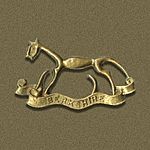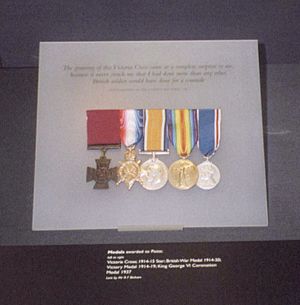Berkshire Yeomanry facts for kids
Quick facts for kids Berkshire Yeomanry |
|
|---|---|

Badge of the Berkshire Yeomanry
|
|
| Active | 20 April 1794 – April 1828 12 February 1831 – present |
| Country | |
| Branch | |
| Type | Yeomanry Cavalry (to 1921) Artillery (1921–61) Armoured reconnaissance (1961–67) Signals (1969–present) |
| Role | Combat Support Signals |
| Size | Three Regiments (First World War) One Regiment (Second World War) One Squadron (current) |
| Part of | 39 (Skinners) Signal Regiment |
| Garrison/HQ | Windsor |
| Engagements | Second Boer War
|
| Commanders | |
| Honorary Colonel | Brigadier Hugh J. Robertson, QVRM, TD, VR |
| Notable commanders |
Br.-Gen. John Tyson Wigan |
The Berkshire Yeomanry was a special part-time army unit in the British Army. It started way back in 1794. Its main job was to help protect Britain from invasion during the French Revolutionary Wars.
This unit was the oldest volunteer group in the Royal County of Berkshire. It has served for over 200 years! The Berkshire Yeomanry fought in the Second Boer War. They also served as soldiers on horseback in the First World War. Later, they became an artillery unit (using big guns) in the Second World War.
Today, their history continues with 94 (Berkshire Yeomanry) Signal Squadron. This squadron is part of 39 (Skinners) Signal Regiment. Their main base is in Windsor, Berkshire. The Berkshire Yeomanry has won many special awards called battle honours. These awards are for battles fought all over the world. One of their soldiers, Private Frederick Potts, even won the Victoria Cross. This is the highest award for bravery in battle.
Contents
- Early Days: French Wars (1794-1814)
- Keeping the Peace in the 1800s
- Imperial Yeomanry and the Boer War (1899-1902)
- The Territorial Force (1908)
- First World War (1914-1918)
- Between the World Wars
- Second World War (1939-1945)
- After the Wars: Modern Era
- Victoria Cross Hero: Fred Potts
- Battle Honours
- Unit Badge
- See also
Early Days: French Wars (1794-1814)
In 1793, Britain worried about being invaded by France. The government decided to create volunteer groups to help defend the country. Soldiers on horseback were called "Gentlemen and Yeomanry Cavalry."
The first group in Berkshire was the Abingdon Yeomanry, formed on April 10, 1794. Soon, many other groups started up. By 1800, there were eight different volunteer cavalry groups in Berkshire. These included units from Reading, Newbury, Woodley, and Windsor.
After a short break in fighting, these groups were re-formed in 1803. More troops were also added, like the Aldermaston Cavalry. In 1804, five of these troops joined together. They formed the 1st Berkshire Cavalry. This was the first time several Berkshire Yeomanry groups worked as one.
Keeping the Peace in the 1800s
After the big Battle of Waterloo in 1815, the Yeomanry units stayed active. They helped the police keep order, as there weren't many police forces back then. Sometimes, the government stopped supporting them, and units were disbanded. But if there was trouble, they would quickly re-form.
In 1831, four independent Yeomanry troops started up again in Berkshire. These included groups from Hungerford and Newbury. By 1874, the Hungerford troop had grown to four troops. Around 1847, they started calling themselves the Royal Berkshire Yeomanry Cavalry. Their official name was the Berkshire Regiment of Yeomanry Cavalry (Hungerford).
By the 1890s, the main headquarters of the regiment moved from Hungerford to Reading.
Imperial Yeomanry and the Boer War (1899-1902)
In 1899, Britain was fighting the Second Boer War in South Africa. The army needed more soldiers. So, the government created the Imperial Yeomanry (IY). This new force was made up of volunteers, often from the Yeomanry units. They were trained to fight on horseback.
The Berkshire Yeomanry formed two companies for this war: the 39th and 58th (Berkshire) Companies. They arrived in South Africa in early 1900. These companies fought alongside other Yeomanry units.
One of their first big fights was the Battle of Boshof on April 5, 1900. The Imperial Yeomanry, even though they were new, fought very well. Their commander praised them for acting like experienced soldiers.
The Berkshire Yeomanry companies then joined a group called "Methuen's Column." This group was known as the "Mobile Marvels" because they moved so fast. They marched long distances, chasing Boer forces. One famous chase was called the "Great de Wet Hunt." The Berkshire Yeomanry helped try to catch a clever Boer leader named Christiaan de Wet.
By the end of the war, about 600 men from the Berkshire Yeomanry had served in South Africa. Their bravery earned them their first special award: South Africa 1900–01. After the war, all Yeomanry regiments in Britain were changed to Imperial Yeomanry. This meant they were trained and equipped to fight on horseback. The Berkshire unit became the Berkshire (Hungerford) Imperial Yeomanry (Dragoons).
The Territorial Force (1908)
In 1908, the regiment was renamed the Berkshire (Hungerford) Yeomanry. It became part of the new Territorial Force. This force was meant for home defense during wartime. The Berkshire Yeomanry was trained as dragoons, which meant they were cavalry soldiers.
Here's how the unit was organized:
| Berkshire (Hungerford) Yeomanry | |
|---|---|
| HQ | Yeomanry House, Reading |
| A Squadron | Windsor (detachments at Maidenhead, Wokingham) |
| B Squadron | Reading (detachment at Wallingford) |
| C Squadron | Newbury (detachments at Hungerford, Lambourn) |
| D Squadron | Wantage (detachments at Abingdon, Faringdon, Didcot) |
First World War (1914-1918)
When the First World War began in August 1914, many members of the Territorial Force volunteered to serve overseas. Because of this, the units were split into three groups:
- 1st Line: These units were ready to fight overseas.
- 2nd Line: These units stayed home for defense.
- 3rd Line: These units trained new soldiers to replace those fighting.
1st Line: 1/1st Berkshire Yeomanry
This unit was sent to Egypt in April 1915. In August 1915, they had to leave their horses behind. They then took part in the Gallipoli Campaign in Turkey. They landed at Suvla Bay and fought in the attack on Scimitar Hill. This was a very tough battle with many losses.
After Gallipoli, the unit returned to Egypt. In 1917, they joined the Imperial Mounted Division. They fought in the First and Second Battles of Gaza. They also took part in the Third Battle of Gaza, including the Battle of Beersheba.
In 1918, the Berkshire Yeomanry was changed. They joined with another unit to form C Battalion, Machine Gun Corps. This new unit was sent to France. They fought on the Western Front for the rest of the war.
2nd Line: 2/1st Berkshire Yeomanry
This unit stayed in Britain for home defense. In 1916, they changed from cavalry to cyclist soldiers. They were stationed in areas like Kent and Suffolk. Later, they moved to Ireland and stayed there until the end of the war.
3rd Line: 3/1st Berkshire Yeomanry
This unit was formed in 1915. Its job was to train new soldiers and send them as replacements to the fighting units.
Between the World Wars
After the First World War, the Berkshire Yeomanry was re-formed in 1920. However, most Yeomanry units were no longer needed as cavalry. So, in 1921, the Berkshire Yeomanry joined with the Royal Buckinghamshire Yeomanry. They became an artillery unit called 99th (Buckinghamshire and Berkshire) Brigade, Royal Field Artillery.
Within this new unit, the Berkshire Yeomanry kept its own identity. They formed two artillery batteries: 395 (Berkshire Yeomanry) Battery and 396 (Berkshire Yeomanry) Battery. Over the years, their name changed a few times. By 1938, they were called 99th (Buckinghamshire and Berkshire Yeomanry) Field Regiment, RA.
Second World War (1939-1945)
As another war seemed likely in 1939, the army decided to double its units. The Berkshire and Buckinghamshire Yeomanry split up again. The Berkshire group became 145th Field Regiment, Royal Artillery.
This regiment stayed in the UK for most of the war. In February 1945, they moved to India. They served with different army divisions there. After the war, they moved to Malaya and Java. The regiment was put on hold in 1946.
After the Wars: Modern Era
The regiment was re-formed in 1947 as 345th (Berkshire Yeomanry) Medium Regiment, RA. Over the next few years, they went through more changes and mergers with other units.
In 1961, they joined the Westminster Dragoons. They became C (Berkshire Yeomanry) Squadron and used armoured cars. This didn't last long. In 1967, the Berkshire part of the unit became A Company (Berkshire Yeomanry), The Royal Berkshire Territorials.
Then, in 1969, they changed their role again. They became 94 (Berkshire Yeomanry) Squadron in the Royal Corps of Signals. This is a special unit that handles communications for the army.
Today, the squadron is part of the Army Reserve. They provide important radio communications for international forces, including NATO's Allied Rapid Rapid Reaction Corps (ARRC).
Victoria Cross Hero: Fred Potts

Trooper Frederick William Owen Potts was a soldier in the 1/1st Berkshire Yeomanry. He won the Victoria Cross, which is the highest award for bravery in battle.
On August 21, 1915, during the Battle of Scimitar Hill at Gallipoli, Private Potts was wounded in the leg. But he stayed for over 48 hours near the enemy trenches with another soldier from his unit who was badly hurt and couldn't move. Finally, he used a shovel like a sled. He dragged his wounded friend over 600 yards to safety, all while being shot at. What an incredibly brave act!
Battle Honours
The Berkshire Yeomanry has been given these special awards for their bravery in battles:
- Second Boer War
- First World War
Arras 1918, Scarpe 1918, Ypres 1918, Courtrai, France and Flanders 1918, Suvla, Scimitar Hill, Gallipoli 1915, Egypt 1915–17, Gaza, El Mughar, Nebi Samwil, Palestine 1917–18
- Second World War
The Royal Artillery, which the Yeomanry joined, was in almost every battle. Because of this, they were given the motto Ubique (meaning "everywhere") instead of individual battle honours.
Unit Badge
The badge of the Berkshire Yeomanry shows the famous Uffington White Horse. This is a huge, ancient chalk figure carved into a hillside in the Vale of White Horse. This area was historically part of Berkshire.
See also
- Imperial Yeomanry
- List of Yeomanry Regiments 1908
- Yeomanry
- Yeomanry order of precedence
- British yeomanry during the First World War
- Second line yeomanry regiments of the British Army
- List of British Army Yeomanry Regiments converted to Royal Artillery
- Royal Corps of Signals


